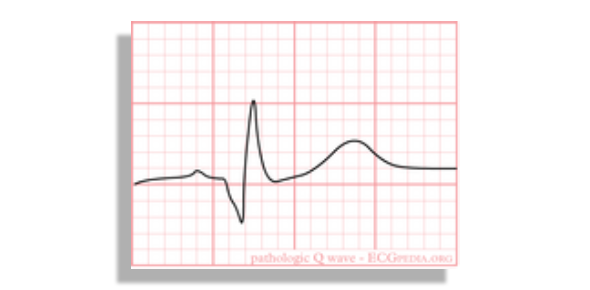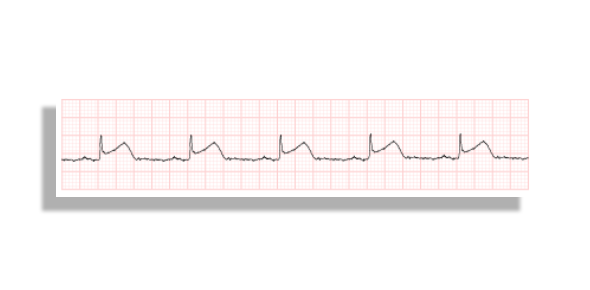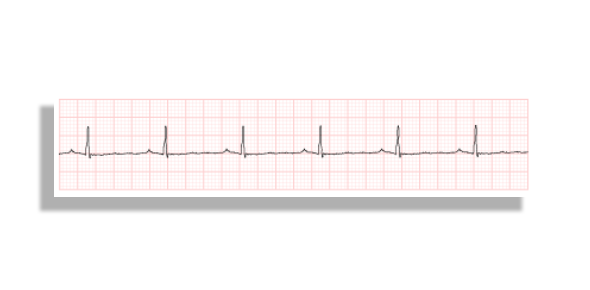ECG Quiz 1

Complete the quiz below to test your knowledge so far on ECG interpretation.
- 1.
Q1. What does the P-wave represent?
- A.
Depolarisation of the ventricles
- B.
Depolarisation of the atrium
- C.
Repolarisation of the ventricles
- D.
Repolarisation of the atrium
Correct Answer
B. Depolarisation of the atriumExplanation
The P-wave represents the depolarization of the atrium. Depolarization is the process in which the electrical charges in the heart muscle cells change, causing the muscle to contract. In this case, the P-wave specifically represents the depolarization of the atrial muscle cells, which initiates the contraction of the atria. This electrical signal then travels through the heart, leading to the contraction of the ventricles and the pumping of blood throughout the body.Rate this question:
-
- 2.
Q2. What is a sign of cardiac ischemia?
- A.
PR-interval widening
- B.
T-wave inversion
- C.
Presence of a U-wave
- D.
P-wave inversion
Correct Answer
B. T-wave inversionExplanation
T-wave inversion is a sign of cardiac ischemia. During cardiac ischemia, there is a disruption in the blood flow to the heart muscle, leading to inadequate oxygen supply. This can cause changes in the electrical activity of the heart, particularly in the repolarization phase represented by the T-wave on an electrocardiogram (ECG). T-wave inversion refers to the abnormal downward deflection of the T-wave, indicating myocardial injury or ischemia. It is commonly seen in conditions such as angina, myocardial infarction, and coronary artery disease.Rate this question:
-
- 3.
Q3. What does this ECG represent?
- A.
Ischemia
- B.
Injury
- C.
STEMI
- D.
Infarction
Correct Answer
D. InfarctionExplanation
This ECG represents infarction. Infarction refers to the death of a specific area of tissue due to lack of blood supply. In the context of an ECG, infarction is indicated by specific changes in the electrical activity of the heart, such as ST-segment elevation or depression. These changes are typically seen in patients with a heart attack or myocardial infarction.Rate this question:
-
- 4.
Q4. What does the QRS complex represent?
- A.
Repolarisation of the ventricles
- B.
Repolarisation of the atrium
- C.
Depolarisation of the ventricles
- D.
Depolarisation of the atrium
Correct Answer
C. Depolarisation of the ventriclesExplanation
The QRS complex on an electrocardiogram (ECG) represents the depolarization of the ventricles. Depolarization is the electrical activation of the heart muscle cells, causing them to contract and pump blood. The QRS complex is a series of waves that indicates the spread of electrical impulses through the ventricles, leading to their contraction. This is an important event in the cardiac cycle as it ensures efficient blood flow throughout the body.Rate this question:
-
- 5.
Q5. How do we know that cardiac injury is occurring to a patient?
- A.
Q-waves
- B.
ST-elevation
- C.
ST-depression
- D.
T-wave inversion
Correct Answer
B. ST-elevationExplanation
ST-elevation is a common indicator of cardiac injury in a patient. When there is an obstruction in the coronary artery, it restricts blood flow to the heart muscle, leading to ischemia. This lack of oxygen causes the affected part of the heart muscle to become electrically unstable, resulting in ST-segment elevation on an electrocardiogram (ECG). This elevation is a clear sign of myocardial infarction or heart attack, indicating that cardiac injury is occurring to the patient.Rate this question:
-
- 6.
Q6. What does this ECG represent?
- A.
NSTEMI
- B.
ST-depression
- C.
STEMI
- D.
T-wave elevation
Correct Answer
C. STEMIExplanation
This ECG represents STEMI (ST-elevation myocardial infarction). STEMI is a type of heart attack that occurs when there is a complete blockage in one of the coronary arteries, leading to a lack of blood flow to a specific area of the heart. The ST-segment elevation on the ECG is a characteristic finding in STEMI and indicates significant damage to the heart muscle. Prompt medical intervention is required in cases of STEMI to restore blood flow and prevent further complications.Rate this question:
-
- 7.
Q7. What occurs at the T-wave?
- A.
Atrial repolarisation
- B.
Ventricle repolarisation
- C.
Atrial depolarisation
- D.
Ventricle depolarisation
Correct Answer
B. Ventricle repolarisationExplanation
The T-wave on an electrocardiogram represents ventricular repolarization. During this phase, the ventricles are resetting their electrical charge in preparation for the next heartbeat. This is important for the heart to function properly and maintain a regular rhythm. Atrial repolarization occurs during the QRS complex, not the T-wave.Rate this question:
-
- 8.
Q8. How wide should the PR-interval be?
- A.
0.04-0.08
- B.
0.08-0.20
- C.
0.12-0.20
- D.
0.08-0.12
Correct Answer
C. 0.12-0.20Explanation
The PR-interval represents the time it takes for the electrical impulse to travel from the atria to the ventricles in the heart. A normal PR-interval is typically between 0.12-0.20 seconds. This range allows for adequate time for the atria to contract and fill the ventricles before they contract. A PR-interval that is too short or too long can indicate abnormalities in the electrical conduction system of the heart.Rate this question:
-
- 9.
Q9. What does this ECG represent?
- A.
Ischemia
- B.
Injury
- C.
Infarction
- D.
ST-depression
Correct Answer
A. IschemiaExplanation
This ECG represents ischemia. Ischemia refers to a lack of blood flow and oxygen to a specific area of the heart, which can be seen on an ECG as changes in the ST segment or T wave. In this case, the ECG likely shows characteristic changes indicative of ischemia, such as ST segment depression. Injury and infarction, on the other hand, typically involve more severe and prolonged lack of blood flow to the heart, and may present with different ECG patterns.Rate this question:
-
- 10.
Q10. How wide should the QRS complex be?
- A.
0.04-0.08
- B.
0.04-0.12
- C.
0.08-0.12
- D.
0.08-0.20
Correct Answer
C. 0.08-0.12Explanation
The QRS complex represents the electrical depolarization of the ventricles in the heart. It is measured from the beginning of the Q wave to the end of the S wave on an electrocardiogram (ECG). The normal duration for the QRS complex is considered to be between 0.08 and 0.12 seconds. This range indicates that the electrical depolarization is occurring within a normal time frame, suggesting that the ventricles are contracting properly.Rate this question:
-
Quiz Review Timeline +
Our quizzes are rigorously reviewed, monitored and continuously updated by our expert board to maintain accuracy, relevance, and timeliness.
-
Current Version
-
Oct 26, 2023Quiz Edited by
ProProfs Editorial Team -
Oct 21, 2010Quiz Created by
RENZED
 Back to top
Back to top





